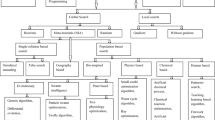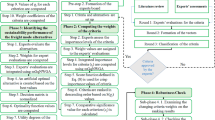Abstract
In the shipping industry, the sustainability of the shipping companies has received more attention besides the economic benefits. A suitable evaluation model can provide a credible sustainable improvement test and guide the operation and management of shipping companies. This study is concerned with a granular evaluation model for the sustainable competitiveness evaluation of container liners, where the interval linguistic version of the analytic hierarchy process is designed for comparing alternatives comprehensively. To obtain ideal consistent preference relations, we propose a modification method by constructing information granules and using particle swarm optimization. Moreover, based on the combination of individual preference relations and experts’ weights obtained from the social network, the aggregated overall opinion of alternatives is achieved. Furthermore, a case study evaluating the sustainable competitiveness of container liners is conducted to support the proposed evaluation framework’s feasibility and practicality.


Similar content being viewed by others
References
Bao J, Zhou Y, Shi P et al.(2020) Sustainable competitiveness evaluation for container liners using a novel hybrid method with intuitionistic fuzzy linguistic variables. Neural Comput Adv Appl 1265:220–233
Yang C, Lu C, Haider J et al.(2013) The effect of green supply chain management on green performance and firm competitiveness in the context of container shipping in Taiwan. Transp Res Part E Logs Transp Rev 55:55–73
Yuen K, Wang X, Wong Y et al.(2017) Antecedents and outcomes of sustainable shipping practices: the integration of stakeholder and behavioural theories. Transp Res Part E Logs Transp Rev 108:18–35
Koberg E, Longoni A (2019) A systematic review of sustainable supply chain management in global supply chains. J Clean Prod 207:1084–1098
Yuen K, Li K, Xu G et al.(2019) A taxonomy of resources for sustainable shipping management: their interrelationships and effects on business performance. Transp Res Part E Logs Transp Rev 128:316–332
Saaty T (1980) The analytic hierarchy process. McGraw-Hill, New York
Tanino T (1984) Fuzzy preference orderings in group decision making. Fuzzy Sets Syst 12(2):117–131
Zadeh L (1965) Fuzzy sets. Inform. Control 8(3):338–353
Cheng H, Chen J (1997) Automatically determine the membership function based on the maximum entropy principle. Informat Sci 96(3–4):163–182
Atanassov K (1986) Intuitionistic fuzzy sets. Fuzzy Sets Syst 20(1):87–96
Torra V (2010) Hesitant fuzzy sets. Int J Intell Syst 25(6):529–539
Yager R (2013) Pythagorean fuzzy subsets. In: Ifsa World Congress and Nafips Meeting 57-61
Zhang S, Xu Z, He Y (2017) Operations and integrations of probabilistic hesitant fuzzy information in decision making. Inform Fus 38:1–11
Gupta M (2011) On fuzzy logic and cognitive computing: some perspectives. Sci Iran 18(3):590–592
Liu P, Liu J, Merigó J (2018) Partitioned heronian means based on linguistic intuitionistic fuzzynumbers for dealing with multi-attribute group decision making. Appl Soft Comput 62:395–422
Zadeh L (1975) The concept of a linguistic variable and its application to approximate reasoning-\({\rm I}\). Inform Sci 8(3):199–249
Cabrerizo F, Hmouz R, Morfeq A et al.(2017) Soft consensus measures in group decision making using unbalanced fuzzy linguistic information. Soft Comput 21(11):3037–3050
Jin F, Ni Z, Chen H et al.(2016) Approaches to group decision making with intuitionistic fuzzy preference relations based on multiplicative consistency. Knowl Based Syst 97:48–59
Liu P, Rong L (2020) Multiple attribute group decision-making approach based on multi-granular unbalanced hesitant fuzzy linguistic information. Int J Fuzzy Syst 22(2):604–618
Huang S (2015) Multi-criteria decision-making method based on prioritized weighted average operator with linguistic \({\rm D}\) numbers. J Jiamusi Univ (Nat Sci Ed) 33(3):464–469
Liu P, Zhang X (2020) A novel approach to multi-criteria group decision-making problems based on linguistic \({\rm D}\) numbers. Comput Appl Math 39(132):2–27
Liu H, Quan M, Li Z et al.(2019) A new integrated \({\rm MCDM}\) model for sustainable supplier selection under interval-valued intuitionistic uncertain linguistic environment. Inform Sci 486:254–270
Pedrycz W, Song M (2014) A granulation of linguistic information in \({\rm AHP}\) decision-making problems. Inform Fus 17:93–101
Tang G, Francisco C, Liu P (2020) A decision-theoretic rough set model with q-rung orthopair fuzzy information and its application in stock investment evaluation. Appl Soft Comput 91:
Song W, Zhu J (2019) A multistage risk decision making method for normal cloud model considering behavior characteristics. Appl Soft Comput 78:393–406
Lang G (2020) A general conflict analysis model based on three-way decision. Int J Mach Learn Cybern 11(5):1083–1094
Sun B, Chen X, Zhang L et al.(2020) Three-way decision making approach to conflict analysis and resolution using probabilistic rough set over two universes. Inform Sci 507:809–822
Zhang C, Li D, Liang J (2020) Multi-granularity three-way decisions with adjustable hesitant fuzzy linguistic multigranulation decision-theoretic rough sets over two universes. Inform Sci 507:665–683
Wang X, Li J (2020) New advances in three-way decision, granular computing and concept lattice. Int J Mach Learn Cybern 11(5):945–946
Liu F, Zhang J, Liu T (2020) A PSO-algorithm-based consensus model with the application to large-scale group decision-making. Complex Intell Syst 6:287–298
Labella L, Cohard J, Martínez J et al.(2020) An AHPSort II based analysis of the inequality reduction within European Union. Mathematics 8(4):646
Alessio I, Menelaos T, Luis M (2020) Analytic hierarchy process-fuzzy sorting: an analytic hierarchy process-based method for fuzzy classification in sorting problems. J Oper Res Soc 71(6):928–947
Ishizaka A, Pearman C, Nemery P (2012) AHPSort: an AHP-based method for sorting problems. Int J Prod Res 50(17):1–18
Saaty T (1977) A scaling method for priorities in hierarchical structures. J Math Psychol 15(3):234–281
Xu Z, Wei C (1999) A consistency improving method in the analytic hierarchy process. Eur J Oper Res 116(2):443–449
Wu J, Chiclana F (2014) A social network analysis trust-consensus based approach to group decision-making problems with interval-valued fuzzy reciprocal preference relations. Knowl Based Syst 59:97–107
Bondy J, Murty U (1977) Graph theory with applications. J Oper Res Soc 28(419):237–238
Dong Y, Ding Z, Martínez L et al.(2017) Managing consensus based on leadership in opinion dynamics. Inform Sci 397:187–205
Horn R, Johnson C (1994) Matrix analysis, 2nd edn. Cambridge University Press, Cambridge
Rosen K (2007) Discrete mathematics and its application, 6th edn. WCB/McGraw-Hill, New York
Xu G, Cui Q, Shi X et al.(2019) Particle swarm optimization based on dimensional learning strategy. Swarm Evolut Comput 45:33–51
Barzilai J (1997) Deriving weights from pairwise comparison matrices. J Oper Res Soc 48(12):1226–1232
Wang J, Peng J, Zhang H et al.(2015) An uncertain linguistic multi-criteria group decision-making method based on a cloud model. Group Decis Negot 24(1):171–192
Liu F (2009) Acceptable consistency analysis of interval reciprocal comparison matrices. Fuzzy Sets Syst 160(18):2686–2700
Cabrerizo F, Herrera V, Pedrycz W (2013) A method based on PSO and granular computing of linguistic information to solve group decision making problems defined in heterogeneous contexts. Eur J Oper Res 230(3):624–633
Cabrerizo F, Molinera J, Pedrycz W et al.(2018) Granulating linguistic information in decision making under consensus and consistency. Expert Syst Appl 99:83–92
Callejas E, Cerrada J, Cerrada C et al.(2019) Group decision making based on a framework of granular computing for multi-criteria and linguistic contexts. IEEE Access 7:54670–54681
Liu F, Zou S, Li Q (2020) Deriving priorities from pairwise comparison matrices with a novel consistency index. Appl Math Comput 374:
Wang L, Liao B, Liu X et al.(2017) Possibility-based ELECTRE II method with uncertain linguistic fuzzy variables. Int J Patt Recogn Artif Intell 31(09):1759016
MAERSK (2020) Sustainability Report 2019. Denmark. https://www.maersk.com.cn/about/sustainability/highlights-2019
Yang M (2020) Corporate social responsibility report 2020. Keelungz: Yang Ming Marine Transport Corp. https://www.yangming.com/investor_relations/Corporate_Governance/CorporateSocialReportList.aspx
Yang M (2020) Consolidated financial report 2019. Keelungz: Yang Ming Marine Transport Corp. https://www.yangming.com/files/Investor_Relations/2019(Consolidated).pdf
Li C, Rodriguez R, Martinez L et al.(2018) Personalized individual semantics based on consistency in hesitant linguistic group decision making with comparative linguistic expressions. Knowl Based Syst 145:156–165
Zhang Z, Guo C (2012) A method for multi-granularity uncertain linguistic group decision making with incomplete weight information. Knowl Based Syst 26:111–119
Acknowledgements
The authors are grateful to the editors and the reviewers for their valuable and constructive comments to improve this paper. This work was supported in part by the Natural Science Foundation of China under Grants (Nos. 61773352, 71971051), and in part by the Fundamental Research Funds for the Central Universities (No. 3132019357).
Author information
Authors and Affiliations
Corresponding author
Additional information
Publisher's Note
Springer Nature remains neutral with regard to jurisdictional claims in published maps and institutional affiliations.
Appendix
Appendix
The relevant information of five container shipping liners is exhibited in Table 3.
Rights and permissions
About this article
Cite this article
Liu, X., Wang, Y. & Wang, L. Sustainable competitiveness evaluation of container liners based on granular computing and social network group decision making. Int. J. Mach. Learn. & Cyber. 13, 751–764 (2022). https://doi.org/10.1007/s13042-021-01325-5
Received:
Accepted:
Published:
Issue Date:
DOI: https://doi.org/10.1007/s13042-021-01325-5




